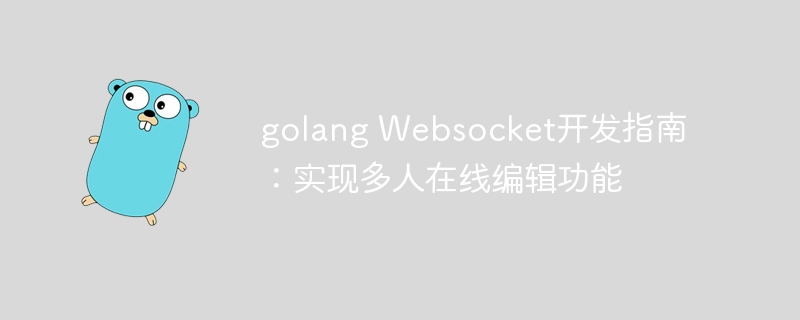Home >Backend Development >Golang >golang Websocket Development Guide: Implementing multi-person online editing function
golang Websocket Development Guide: Implementing multi-person online editing function
- WBOYWBOYWBOYWBOYWBOYWBOYWBOYWBOYWBOYWBOYWBOYWBOYWBOriginal
- 2023-12-02 13:42:19909browse

Golang Websocket Development Guide: Implementing Multi-person Online Editing Function
Overview:
With the rapid development of the Internet, the development of Web applications is becoming more and more popular. focus on. In particular, some applications need to implement the function of online collaborative editing by multiple people. A simple and effective way to achieve this is to use Websocket.
Websocket is a full-duplex communication protocol based on the TCP protocol. It can establish a persistent connection between the client and the server and enable the server to actively push messages to the client. In this article, we will use Golang to implement a simple multi-person online editing function so that multiple users can edit the same document at the same time.
Implementation steps:
-
Initialize a Golang project
Before we start, we need to initialize a Golang project. You can use the following command:mkdir coedit cd coedit go mod init github.com/your-username/coedit
-
Install Gorilla WebSocket library
Gorilla WebSocket is an excellent Golang library used to implement Websocket functions. We can install it with the following command:go get github.com/gorilla/websocket
-
Create a Websocket server
First, we need to create a Websocket server in Golang. Create a file namedmain.goand add the following code:package main import ( "log" "net/http" "github.com/gorilla/websocket" ) var ( clients = make(map[*websocket.Conn]bool) //保存所有连接的客户端 broadcast = make(chan []byte) //广播消息的通道 upgrader = websocket.Upgrader{} //升级器 ) func main() { fs := http.FileServer(http.Dir("static")) http.Handle("/", fs) // 当有新的websocket请求时,升级连接,并处理收到的消息 http.HandleFunc("/ws", handleConnections) // 启动广播器 go handleMessages() log.Println("Server started on :8000") log.Fatal(http.ListenAndServe(":8000", nil)) } func handleConnections(w http.ResponseWriter, r *http.Request) { //升级请求并检查错误 ws, err := upgrader.Upgrade(w, r, nil) if err != nil { log.Println(err) return } //关闭连接 defer ws.Close() //注册新的客户端 clients[ws] = true for { var msg []byte //读取消息并检查错误 _, msg, err = ws.ReadMessage() if err != nil { log.Println(err) delete(clients, ws) break } //将消息发送到广播通道 broadcast <- msg } } func handleMessages() { for { //从广播通道中读取消息 msg := <-broadcast //向客户端发送消息 for client := range clients { err := client.WriteMessage(websocket.TextMessage, msg) if err != nil { log.Println(err) client.Close() delete(clients, client) } } } }
This code first imports the required packages and then defines some global variables . handleConnectionsThe function is used to handle Websocket connections and messages associated with them. handleMessagesThe function is used to receive messages from the broadcast channel and send the messages to all clients.
-
Create HTML file
Create a folder namedstaticin the project root directory, and then create a folder namedindex.htmlfile and add the following code:<!DOCTYPE html> <html> <head> <meta charset="UTF-8"> <title>CoEdit Online Editor</title> <style> #editor { width: 100%; height: 500px; font-size: 14px; line-height: 18px; } </style> </head> <body> <div id="editor"></div> <script> var socket = new WebSocket("ws://localhost:8000/ws"); var editor = ace.edit("editor"); editor.setTheme("ace/theme/twilight"); editor.getSession().setMode("ace/mode/javascript"); socket.onmessage = function(event) { editor.setValue(event.data); }; editor.on("input", function() { socket.send(editor.getValue()); }); </script> <script src="https://cdnjs.cloudflare.com/ajax/libs/ace/1.4.6/ace.js"></script> </body> </html>
This code creates a simple text editor using the ace library. It also creates a Websocket connection and updates the editor's contents when messages are received. When the user edits text, the changes are sent to the server.
-
Run the application
Run the following command in the terminal to start the application:go run main.go
Now, it can be accessed in the browser http://localhost:8000, multiple users can enter this page at the same time and collaboratively edit the same document.
Summary:
This article introduces the method of using Golang and Websocket to achieve multi-person online collaborative editing. By creating Websocket servers and HTML pages, users can edit and share documents in real time. This is just a simple example, you can extend the functionality according to actual needs and add some logic on the server side to control editing permissions between users, etc.
Implementing multi-person online editing functions in this way can effectively enhance collaboration and real-time performance, and provide users with a better user experience. I hope this article can help you in Websocket development and enable you to better apply this technology.
The above is the detailed content of golang Websocket Development Guide: Implementing multi-person online editing function. For more information, please follow other related articles on the PHP Chinese website!

